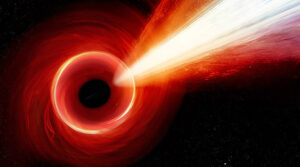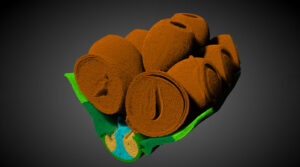A study explores how the behavior of electrons changes on the mesoscale under magnetic fields and rotation.
Recently, the development of increasingly miniaturized computers and other electronics has sparked a surge of interest in understanding the physical phenomena that occur on the nanometer scale, which occupies an intermediate space between the microscopic world of elementary particles and macroscopic objects described by classical physics.
At this “mesoscopic” scale, which is larger than individual atoms and molecules, but still small enough that quantum effects are important, quantum mechanics are often necessary to understand and describe these systems accurately. This makes the theoretical study of these objects very challenging, as quantum mechanical calculations are generally more complicated than classical.
If a mesoscopic-sized system is part of an instrument or gadget, it may be subjected to various external influences, such as magnetic and electric fields, pressure, rotation, and acceleration, whether intentional or not. Understanding how these factors affect the physical properties of a mesoscopic object is important for designing a functioning apparatus that works as it was intended.
Magnetic fields and rotation
To find how magnetic fields and rapid rotation change the properties of mesoscopic systems, physicists from the Universidade Federal do Maranhão in Brazil by Luís Fernando Pereira and Edilberto Silva analyzed the behavior of electrons in a rotating ring that was placed in a magnetic field. The researchers were interested in electrons because these particles are responsible for a material’s magnetic and conductive properties, among others.
In their theoretical study, which included extensive numerical simulations, the scientists considered a ring with a diameter of less than one micrometer that could represent a rotating part of a real device. When not rotating, the physicists found that the behavior of electrons was consistent with previous studies. Specifically, almost all the electrons, except for those located close to the edges of the ring, existed in states with the same energy called Landau states. The electrons at the edge states have higher energies.
It is known that if a system is rotating, it is affected by centrifugal force, like a person riding a carousel. The scientists therefore expected that, in a similar way, that inclusion of rotation in their analysis would influence the behavior of the electrons. When they rotated the ring around its axis at a frequency of about 100 gigahertz, they found that while the energies of the edge electrons remained almost the same, the energies of the Landau electrons changed, and the closer to the outer edge of the ring this electron was, the lower its energy.
Where can this be applied?
This change in behavior of individual electrons is interesting in itself, but what is even more significant is how it affected the physical properties of the ring as a whole. One of these is magnetization, which characterizes the response of the system to an applied magnetic field.
Normally magnetization exhibits a sharp sawtooth oscillations with a constant amplitude depending on the magnetic field, and this is what the researchers observed when the ring was not rotating. However, when rotation was switched on, while the shape of the oscillations remained almost the same, the amplitude of the oscillations decreased. Furthermore, the oscillations became significant at lower values of the magnetic field.
These findings concerning the influence of the rotation on the behavior of electrons and the physical properties of a mesoscopic ring are interesting not only from a scientific point of view, but the researchers believe that their may find practical applications in the near future.
For example, it has recently been shown that a tiny part can rotate at high speeds when irradiated with light, and a new nano-sized sensor with rotating metal plate has also been tested. Given the rate at which the field of nano- and microdevices is developing, the authors are confident that these examples are just the beginning, and their study will be useful for a wide class of devices with mesoscopic rotating parts.
Reference: L. F. C. Pereira, E. O. Silva, Modification of Landau Levels in a 2D Ring Due to Rotation Effects and Edge States, Annalen der Physik (2023). DOI: 10.1002/andp.202200371
Feature image credit: geralt on Pixabay












+ There are no comments
Add yours